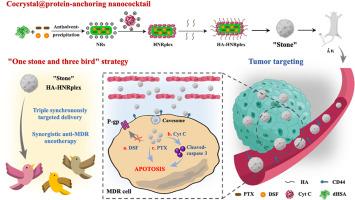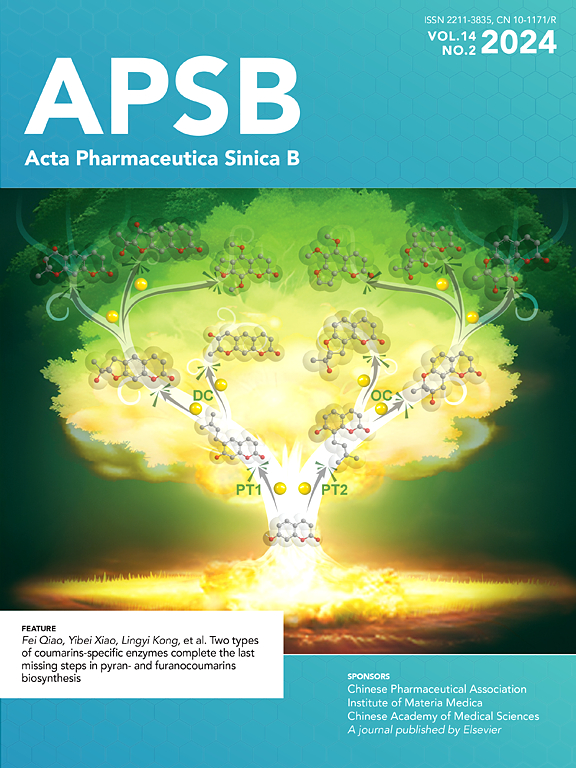Cocrystal@protein-anchoring nanococktail for combinatorially treating multidrug-resistant cancer
IF 14.7
1区 医学
Q1 PHARMACOLOGY & PHARMACY
引用次数: 0
Abstract
Multidrug resistance (MDR), the major mechanism by which various cancers develop specific resistance to therapeutic agents, has set up enormous obstacles to many forms of tumor chemotherapy. Traditional cocktail therapy administration, based on the combination of multiple drugs for anti-MDR chemotherapy, often suffers from inconsistent in vivo pharmacokinetic behaviors that cannot act synchronously on the lesions, leading to limited pharmacodynamic outcomes. Despite the emergence of nanomedicines, which has improved chemotherapeutic drugs’ bioavailability and therapeutic effect on clinical application, these monotherapy-based nano-formulations still show poor progression in overcoming MDR. Herein, a “one stone and three birds” nanococktail integrated by a cocrystal@protein-anchoring strategy was purposed for triple-payload delivery, which paclitaxel-disulfiram cocrystal-like nanorods (NRs) were anchored with the basic protein drug Cytochrome c (Cyt C), followed by hyaluronic-acid modification. In particular, NRs were utilized as carrier-like particles to synchronously deliver biomacromolecule Cyt C into tumor cells and then promote cell apoptosis. Of note, on A549/Taxol drug-resistant tumor-bearing mice, the system with extraordinarily high encapsulation efficiency demonstrated prolonged in vivo circulation and increased tumor-targeting accumulation, significantly reversing tumor drug resistance and improving therapeutic efficacy. Our mechanistic study indicated that the system induced the apoptosis of Taxol-resistant tumor cells through the signal axis P-glycoprotein/Cyt C/caspase 3. Collectively, this nanococktail strategy offers a promising approach to improve the sensitivity of tumor cells to chemotherapeutic drugs and strengthen intractable drug-resistant oncotherapy.

用于组合治疗耐多药癌症的 Cocrystal@ 蛋白锚定纳米鸡尾酒
多药耐药性(MDR)是各种癌症对治疗药物产生特异性耐药性的主要机制,它给多种形式的肿瘤化疗设置了巨大障碍。传统的鸡尾酒疗法是在多种药物联合作用的基础上进行抗 MDR 化疗,但往往存在药代动力学行为不一致的问题,无法同步作用于病灶,导致药效学效果有限。尽管纳米药物的出现提高了化疗药物在临床应用中的生物利用度和治疗效果,但这些基于单药治疗的纳米制剂在克服 MDR 方面仍然进展缓慢。本研究采用 "一石三鸟 "的纳米鸡尾酒法,将紫杉醇-双硫仑共晶纳米棒(NRs)与基础蛋白药物细胞色素(Cyt C)锚定,然后进行透明质酸修饰,从而实现三重载药。特别是,NRs 被用作类似载体的颗粒,将生物大分子 Cyt C 同步递送到肿瘤细胞中,然后促进细胞凋亡。值得注意的是,在 A549/Taxol 耐药肿瘤小鼠身上,这种具有超高封装效率的系统表现出了延长循环时间和增加肿瘤靶向积累的特性,显著逆转了肿瘤耐药性并提高了疗效。我们的机理研究表明,该系统通过 P-glycoprotein/Cyt C/caspase 3 信号轴诱导抗 Taxol 的肿瘤细胞凋亡。总之,这种纳米鸡尾酒策略为提高肿瘤细胞对化疗药物的敏感性和加强棘手的耐药性肿瘤治疗提供了一种前景广阔的方法。
本文章由计算机程序翻译,如有差异,请以英文原文为准。
求助全文
约1分钟内获得全文
求助全文
来源期刊

Acta Pharmaceutica Sinica. B
Pharmacology, Toxicology and Pharmaceutics-General Pharmacology, Toxicology and Pharmaceutics
CiteScore
22.40
自引率
5.50%
发文量
1051
审稿时长
19 weeks
期刊介绍:
The Journal of the Institute of Materia Medica, Chinese Academy of Medical Sciences, and the Chinese Pharmaceutical Association oversees the peer review process for Acta Pharmaceutica Sinica. B (APSB).
Published monthly in English, APSB is dedicated to disseminating significant original research articles, rapid communications, and high-quality reviews that highlight recent advances across various pharmaceutical sciences domains. These encompass pharmacology, pharmaceutics, medicinal chemistry, natural products, pharmacognosy, pharmaceutical analysis, and pharmacokinetics.
A part of the Acta Pharmaceutica Sinica series, established in 1953 and indexed in prominent databases like Chemical Abstracts, Index Medicus, SciFinder Scholar, Biological Abstracts, International Pharmaceutical Abstracts, Cambridge Scientific Abstracts, and Current Bibliography on Science and Technology, APSB is sponsored by the Institute of Materia Medica, Chinese Academy of Medical Sciences, and the Chinese Pharmaceutical Association. Its production and hosting are facilitated by Elsevier B.V. This collaborative effort ensures APSB's commitment to delivering valuable contributions to the pharmaceutical sciences community.
 求助内容:
求助内容: 应助结果提醒方式:
应助结果提醒方式:


